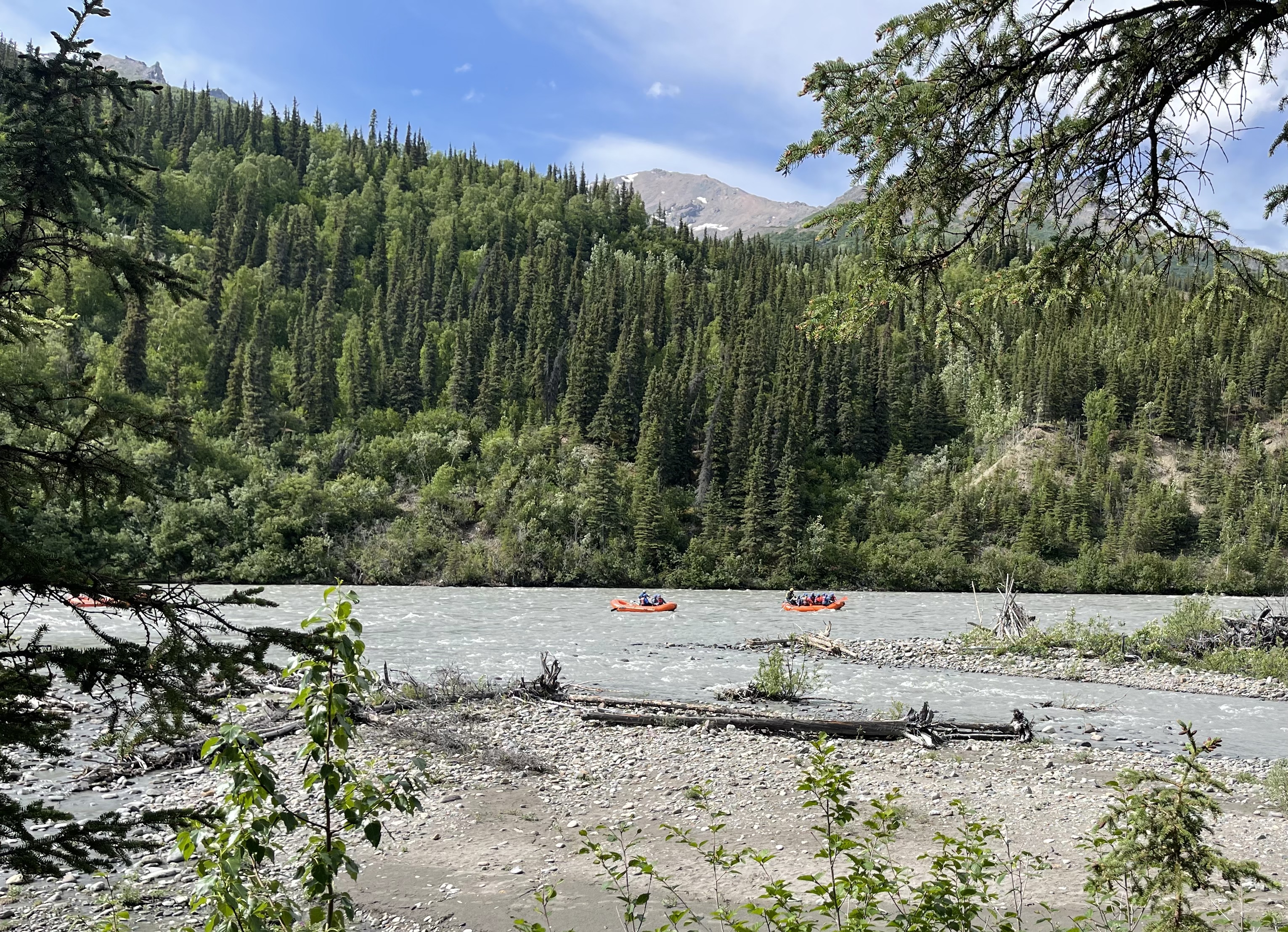|
Four Mile Road, Alaska
Four Mile Road is a census-designated place (CDP) in Yukon-Koyukuk Census Area, Alaska, United States. The population was 43 at the 2010 census, up from 38 in 2000. Geography Four Mile Road is located at (64.596324, -149.125480). It is located next to George Parks Highway or you can get there by the Nenana Municipal Airport in Nenana down South. According to the United States Census Bureau, the CDP has a total area of , of which, of it is land and 1.10% is water. To the right of the city, there is the Nenana River. Demographics Four Mile Road first appeared on the 2000 U.S. Census as a census-designated place (CDP). As of the census of 2000, there were 38 people, 16 households, and 10 families residing in the CDP. The population density was . There were 19 housing units at an average density of . The racial makeup of the CDP was 73.68% White and 26.32% Native American. There were 16 households, out of which 31.3% had children under the age of 18 living with them, 50.0% ... [...More Info...] [...Related Items...] OR: [Wikipedia] [Google] [Baidu] |
Census-designated Place
A census-designated place (CDP) is a concentration of population defined by the United States Census Bureau for statistical purposes only. CDPs have been used in each decennial census since 1980 as the counterparts of incorporated places, such as self-governing cities, towns, and villages, for the purposes of gathering and correlating statistical data. CDPs are populated areas that generally include one officially designated but currently unincorporated community, for which the CDP is named, plus surrounding inhabited countryside of varying dimensions and, occasionally, other, smaller unincorporated communities as well. CDPs include small rural communities, edge cities, colonias located along the Mexico–United States border, and unincorporated resort and retirement communities and their environs. The boundaries of any CDP may change from decade to decade, and the Census Bureau may de-establish a CDP after a period of study, then re-establish it some decades later. Most unin ... [...More Info...] [...Related Items...] OR: [Wikipedia] [Google] [Baidu] |
Census-designated Place
A census-designated place (CDP) is a concentration of population defined by the United States Census Bureau for statistical purposes only. CDPs have been used in each decennial census since 1980 as the counterparts of incorporated places, such as self-governing cities, towns, and villages, for the purposes of gathering and correlating statistical data. CDPs are populated areas that generally include one officially designated but currently unincorporated community, for which the CDP is named, plus surrounding inhabited countryside of varying dimensions and, occasionally, other, smaller unincorporated communities as well. CDPs include small rural communities, edge cities, colonias located along the Mexico–United States border, and unincorporated resort and retirement communities and their environs. The boundaries of any CDP may change from decade to decade, and the Census Bureau may de-establish a CDP after a period of study, then re-establish it some decades later. Most unin ... [...More Info...] [...Related Items...] OR: [Wikipedia] [Google] [Baidu] |
Poverty Line
The poverty threshold, poverty limit, poverty line or breadline is the minimum level of income deemed adequate in a particular country. The poverty line is usually calculated by estimating the total cost of one year's worth of necessities for the average adult.Poverty Lines – Martin Ravallion, in The New Palgrave Dictionary of Economics, 2nd Edition, London: Palgrave Macmillan The cost of housing, such as the rent for an apartment, usually makes up the largest proportion of this estimate, so economists track the real estate market and other housing cost indicators as a major influence on the poverty line. Individual factors are often used to account for various circumstances, such as whether one is a parent, elderly, a child, married, etc. The poverty threshold may be adjusted annually. In practice, like the definition of poverty, the official or common understanding of the poverty line is significantly higher in developed countries than in developing countries. In October 20 ... [...More Info...] [...Related Items...] OR: [Wikipedia] [Google] [Baidu] |
Per Capita Income
Per capita income (PCI) or total income measures the average income earned per person in a given area (city, region, country, etc.) in a specified year. It is calculated by dividing the area's total income by its total population. Per capita income is national income divided by population size. Per capita income is often used to measure a sector's average income and compare the wealth of different populations. Per capita income is also often used to measure a country's standard of living. It is usually expressed in terms of a commonly used international currency such as the euro or United States dollar, and is useful because it is widely known, is easily calculable from readily available gross domestic product (GDP) and population estimates, and produces a useful statistic for comparison of wealth between sovereign territories. This helps to ascertain a country's development status. It is one of the three measures for calculating the Human Development Index of a country. Per ... [...More Info...] [...Related Items...] OR: [Wikipedia] [Google] [Baidu] |
Marriage
Marriage, also called matrimony or wedlock, is a culturally and often legally recognized union between people called spouses. It establishes rights and obligations between them, as well as between them and their children, and between them and their in-laws. It is considered a cultural universal, but the definition of marriage varies between cultures and religions, and over time. Typically, it is an institution in which interpersonal relationships, usually sexual, are acknowledged or sanctioned. In some cultures, marriage is recommended or considered to be compulsory before pursuing any sexual activity. A marriage ceremony is called a wedding. Individuals may marry for several reasons, including legal, social, libidinal, emotional, financial, spiritual, and religious purposes. Whom they marry may be influenced by gender, socially determined rules of incest, prescriptive marriage rules, parental choice, and individual desire. In some areas of the world, arrang ... [...More Info...] [...Related Items...] OR: [Wikipedia] [Google] [Baidu] |
Race (United States Census)
Race and ethnicity in the United States census, defined by the federal Office of Management and Budget (OMB) and the United States Census Bureau, are the Self-concept, self-identified categories of Race and ethnicity in the United States, race or races and ethnicity chosen by residents, with which they most closely identify, and indicate whether they are of Hispanic or Latino (demonym), Latino origin (the only Race and ethnicity in the United States, categories for ethnicity). The racial categories represent a social-political construct for the race or races that respondents consider themselves to be and, "generally reflect a social definition of race recognized in this country." OMB defines the concept of race as outlined for the U.S. census as not "scientific or anthropological" and takes into account "social and cultural characteristics as well as ancestry", using "appropriate scientific methodologies" that are not "primarily biological or genetic in reference." The race cat ... [...More Info...] [...Related Items...] OR: [Wikipedia] [Google] [Baidu] |
Census
A census is the procedure of systematically acquiring, recording and calculating information about the members of a given population. This term is used mostly in connection with national population and housing censuses; other common censuses include censuses of agriculture, traditional culture, business, supplies, and traffic censuses. The United Nations (UN) defines the essential features of population and housing censuses as "individual enumeration, universality within a defined territory, simultaneity and defined periodicity", and recommends that population censuses be taken at least every ten years. UN recommendations also cover census topics to be collected, official definitions, classifications and other useful information to co-ordinate international practices. The UN's Food and Agriculture Organization (FAO), in turn, defines the census of agriculture as "a statistical operation for collecting, processing and disseminating data on the structure of agriculture, covering th ... [...More Info...] [...Related Items...] OR: [Wikipedia] [Google] [Baidu] |
Nenana River
The Nenana River ( taa, Nina No’) is a tributary of the Tanana River, approximately long, in central Alaska in the United States. It drains an area on the north slope of the Alaska Range on the south edge of the Tanana Valley southwest of Fairbanks. It issues from the Nenana Glacier in the northern Alaska Range, southwest of Mount Deborah, approximately 100 mi (160 km) south of Fairbanks. It flows briefly southwest, then west, then north, forming the eastern boundary of Denali National Park and Preserve. It emerges from the mountains onto the broad marshy Tanana Valley, joining the Tanana River from the south at Nenana, Alaska, approximately southwest of Fairbanks. The Tanana River continues to its confluence with the Yukon River. The upper valley of the river furnishes approximately 100 mi (160 km) of the northern route of both the Alaska Railroad and the Parks Highway (Alaska State Highway 3) connecting Fairbanks and Anchorage. The Nenana supports popul ... [...More Info...] [...Related Items...] OR: [Wikipedia] [Google] [Baidu] |
Nenana, Alaska
Nenana ( taa, Toghotili; is a home rule city in the Yukon-Koyukuk Census Area of the Unorganized Borough in the Interior of the U.S. state of Alaska. Nenana developed as a Lower Tanana community at the confluence where the tributary Nenana River enters the Tanana. The population was 378 at the 2010 census, down from 402 in 2000. Completed in 1923, the Mears Memorial Bridge was built over the Tanana River as part of the territory's railroad project connecting Anchorage and Fairbanks. History and culture Nenana is in the westernmost portion of Tanana territory. (The Tanana are among the large Dené language family, also known as Athabascan.) The town was first known by European Americans as ''Tortella,'' a transliteration of the Indian word ''Toghotthele'', which means "mountain that parallels the river." It was later named for the river and the Nenana people who live nearby. The Nenana people became accustomed to contact with Europeans, due to trading journeys to the Villa ... [...More Info...] [...Related Items...] OR: [Wikipedia] [Google] [Baidu] |
Nenana Municipal Airport
Nenana Municipal Airport is a city-owned public-use airport located one mile (1.6 km) south of the central business district of Nenana, a city in the Yukon-Koyukuk Census Area of the U.S. state of Alaska. Facilities and aircraft Nenana Municipal Airport covers which contains two runways: 4L/22R with a 4,600 x 100 ft (1,402 x 30 m) asphalt pavement and 4R/22L with a 2,520 x 60 ft (768 x 18 m) turf surface. It also has a seaplane landing area designated 4W/22W which measures 3,601 x 100 ft (1,098 x 30 m). For 12-month period ending December 31, 2005, the airport had 6,000 aircraft operations, an average of 16 per day: 58% general aviation and 42% air taxi. There are 15 aircraft based at this airport: 93% single engine and 7% multi-engine. References External links FAA Alaska airport diagram(GIF The Graphics Interchange Format (GIF; or , see pronunciation) is a bitmap image format that was developed by a team at the online services provider ... [...More Info...] [...Related Items...] OR: [Wikipedia] [Google] [Baidu] |
George Parks Highway
The George Parks Highway (numbered Interstate A-4 and signed Alaska Route 3), usually called simply the Parks Highway, runs 323 miles (520 km) from the Glenn Highway 35 miles (56 km) north of Anchorage to Fairbanks in the Alaska Interior. The highway, originally known as the Anchorage-Fairbanks Highway, was completed in 1971, and given its current name in 1975. The highway, which mostly parallels the Alaska Railroad, is one of the most important roads in Alaska. It is the main route between Anchorage and Fairbanks (Alaska's two largest metropolitan areas), the principal access to Denali National Park and Preserve and Denali State Park, and the main highway in the Matanuska-Susitna Valley. The route's Interstate designation is not signed; rather, its entire length is signed as Alaska Route 3. It is a common misconception that the name "Parks Highway" comes from the road's proximity to the Denali state and national parks; it is in fact in honor of George Alexander Park ... [...More Info...] [...Related Items...] OR: [Wikipedia] [Google] [Baidu] |





